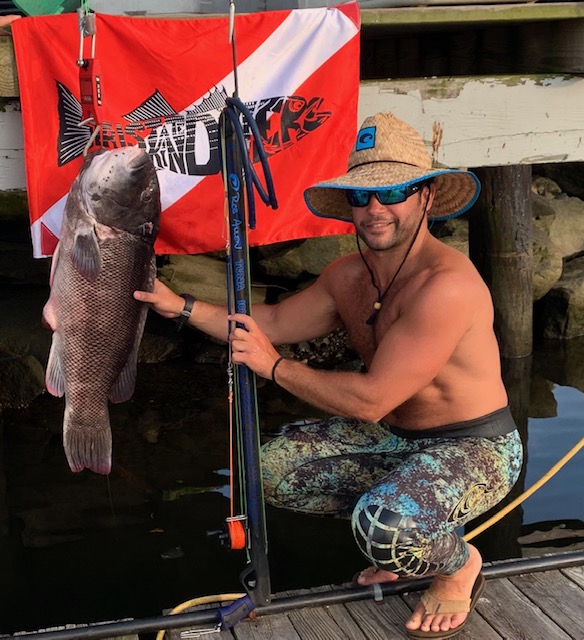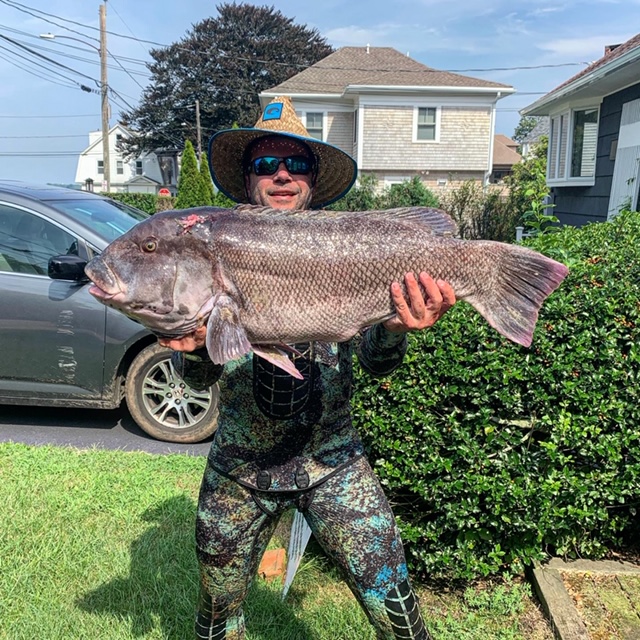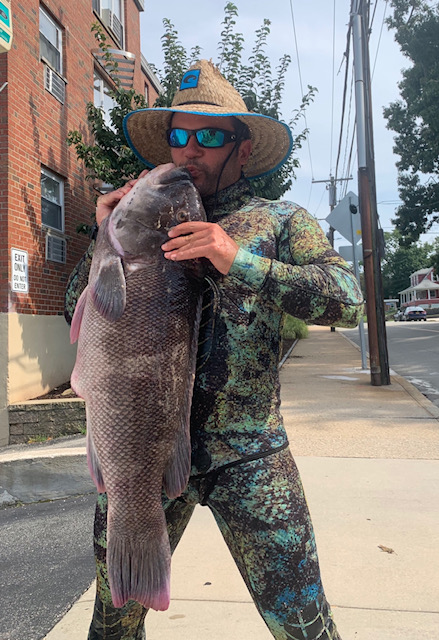
Men’s Speargun World Record Tautog
Story By Brendan Dyer
Men’s Speargun World Record
Tautog – 25.1 lbs/31.75 inches
Brendan Dyer – 8/18/19
Fish Shot approx. 2:45pm

I had been looking forward to this weekend for some time, due to the full moon coinciding with a Friday and the subsequent weekend waning. Year after year I had consistently seen and shot my largest fish during the 36 hours before and after the July and August full moons. The forecast for Saturday called for overcast skies, with light wind; this could not have been more inaccurate. The morning brought torrential rain and seasonably cool temps. The intense nature of this squall, combined with the outgoing tide, caused horrific visibility for the remainder of Saturday. The runoff from the Thames river was being pulled to sea all afternoon with the outgoing tide, essentially rendering eastern Long Island Sound undiveable. I decided to save my energy and wait for Sunday, recognizing that visibility would likely still be poor.
Sunday morning came and the visibility had recovered slightly but was by no means ideal. There was a slight wind swell in the water with waves in the 1-2ft range. I got into the water around 12:15pm and headed to a favorite shore dive location which I had been consistently diving, with and without a gun, for 20 years. The reef requires a decent swim but I have always enjoyed that aspect of the spot. After about a 15 minute swim I reached the outer edge of the reef and began my breath up.
I took my normal sequence of dives, working my way down the reef, drifting with the current. There was a good amount of moving water that day, with an east current running around 2 kts. The current allowed me to cover a lot of ground on each drop, however also made it difficult to stay over specific ledges and rocks during my surface intervals. I had gotten to know this reef so well over the years that I often would visit specific overhangs and holes; which typically guaranteed to produce good size Blackfish. In fact, given the nature of blackfish behavior, I would often see specific fish at specific spots in the reef. Over the course of the next hour or so I dealt with varying degrees of visibility, ranging from 1 foot to about 12 feet. There was a ton of activity on the reef, including huge schools of silverside minnows, a healthy school of striped bass in the 15lb class, and upwards of 150 or so Tog.
I had multiple opportunities to take several Tog that afternoon, but I held off; looking for a larger fish. My tentative plan was to take one good size fish, likely 8-10lbs, which would be enough meat to make ceviche for my family that evening, as well as share some with the neighbors. I rarely if ever took advantage of the bag limit, which was 2 fish per person per day. Due to the blackfish’s territorial nature, and their exceptionally slow growth, I had always been sensitive about harvesting too many fish from the reef in a given year. This would be my 5th fish from this reef this year, with the season having been opened nearly 8 weeks.
I had been diving for about an hour at this point. I dropped past 20ft, careful not to disturb the 5 or so fish on the bottom as I descended. While laying on the reef and sizing up the fish in my immediate vicinity, something caught my eye in the distance. I was in a spot of good visibility but was only able to make out a massive silhouette. The mass was moving very slowly and was well out of range of my vision and my gun. The fish was facing me head on. I initially thought it might be 40+ lb bass due to the size of the head from top to bottom. Then the shadow quartered away, and I could just barely make out the profile. It was a tautog; or at least it was shaped like one… I was at the end of my breathold and headed to the surface. I tried to assess if my eyes had been playing tricks on me given the distance and the poor visibility; either way, I knew I had to get a look at this fish again.
> I fought the current while breathing up; giving myself and extra minute so that I would have a longer bottom time. I tried my best to drop into the same clearing in the reef, pushing farther up current towards the vicinity of the shadow. I saw several mid size fish on this drop, but no trace of the aberration. I continued pushing up current, dropping consistently in the area of the initial siting. Over the next hour, I would see the shadow in the distance on maybe a third of my dives. On a couple drops, I was able to make out the signature white chin. Each time I would see the fish, I would have to battle my heart rate during the following breath up.
After not seeing the fish for 3 consecutive drops, I was starting to get discouraged. My legs were feeling the effects of fighting the current for an hour. I was wishing that I had drank more water prior to getting in. I told myself I would give it one more drop; and then head down current to find dinner. On this drop, I found myself back in the original spot where I had first seen the fish, having been pushed back down the reef. I dropped to 22 feet, laying on the sandy bottom with a large hunk of reef to my left. I rested my left flank and non shooting elbow against the moss-covered slab. In front of me and to my right was another high point in the reef which created a natural choke point. I laid as still as I could and focused on relaxing and keeping my heart rate low. I made sure my fins were pinned flat against the bottom and had my non shooting hand laid up under my right forearm for support, keeping the muzzle just of the seafloor. There were several small togs darting about above my head and a few out in front. Towards the backend of my breathold the shadow materialized in the distance again. Due to the nature of the choke point in the reef, he was forced to round a corner created by the slab to my right, in order to get a good look at me. This time, he inched closer, giving me my first proper look at this amazing creature. I distinctly remember the lips and the eyes. The sheer scale was hard to comprehend. I remained focused on the hunt and diverted my eyes; looking at the sand and using my peripherals to track the fish. A tactic that had proven effective over the years. This was enough to get him to close the distance slightly, before beginning to quarter away again. He was 3-4 gun lengths from my position on the reef, moving towards the edge of my shooting range and visibility. I felt the shot was makeable given the angle required, my muzzle position, and his movement towards my shooting hand. I began to extend the gun as slowly as I could towards the fish. Just before full extension I squeezed the trigger, focusing on my sight picture and intended target. The shaft impacted in the head behind the eye. I would later discover that this shot was about an inch higher than my intended target; which would have stoned him. Given the range things could have gone much differently. I thought the shot would hold, based on the thickness of the skull, and I was getting close to my safe breathold limit. I took off for the surface. He bolted in the opposite direction taking reel line with him. I tightened my drag, trying to keep tension on him to keep him out of the reef.
When I reached the surface, my adrenaline was jacked. I knew this was a world class fish, but the fight was far from over. I gave a couple yanks on my reel line and felt like my shaft had been bolted to the reef. Precisely what I didn’t want to happen had happened. Instinctively tog will wedge themselves into any space in the reef when shot or hooked, unless they are stoned right away. Because my shot was high, I had not impacted his brain, he was still full of fight and had jammed himself somewhere below. I tried to get my heart rate down on the surface but was struggling due to the adrenaline. After 45 seconds I took a good breath and followed my shooting line down into the reef. The fish had laid up under an overhanging slab, and the shaft was caught perpendicular to the crack. I placed my fins on the bottom, reached both hands up under the overhang, and grabbed the shaft. I gave 2 or 3 good yanks, and freed both the fish and the shaft. As soon as the fish was free, I lost grip on the shaft and he accelerated for the surface. I followed close behind. As I reached the surface, he did a 180 and bolted for the bottom. This time I was able to stop him with my shooting line and begin working him to the surface. When I was within range to grasp the fish and the shaft, I noticed the shot was high in the forehead and was afraid that with the power of the fish, he could rip off. I decided to bear hug the fish and I flipped onto my back. After about 10- 15 mins of finning, I finally came ashore and got my first proper look at the sheer size of the animal.
I knew right away this fish had to be a record. My dad and I got him on ice within minutes of making landfall, and I started making calls to fellow TriState Skindivers who might know how to handle world record protocol. We made a quick pit stop to get a measurement and a couple of photos, the fish was 31.75 inches long. The first call I made was to Mitch Bellanger, a friend and fellow Tristate member. When I initially relayed the measurement of almost 32 inches, there was some distortion, and I believe they heard me say 22 inches. A quick congrats for likely taking the lead in the season long club tournament. I then emphatically repeated the measurements, being 10 inches longer than they initially interpreted, and all hell broke loose on the other end. I told Mitch to start making calls and I would get back to him with a weight. We headed to Captain Scotts Lobster Dock where we had access to a large fish box to hold the fish in the interim.
Josh Brouwer arrived shortly thereafter with a certified scale and the knowledge of the proper procedures for measuring and documenting the fish for the record submissions. We quickly got the scale set up and began the proper documentation. I struggled to get the scale hook into the gill plate and raise the fish from the tote. When the scale was hooked up, and I was clear from the fish, the number read 25.1 lbs. We were collectively ecstatic. The previous record was 23.9lbs.
After the dust settled and all the measurements and photos taken, I had a tough choice to make. Generally, when world records are on the line (both gun and rod and reel), the fish is frozen whole, ungutted, so that if there is some dispute with the submission additional measurements can be provided. While this process would protect my pending record, the meat would be wasted. I am not opposed to records in any way, and respect those that pursue them, but I had always eaten every fish I had killed. I spoke with club president Mike Landeau who was on his way back from an offshore Tuna trip. Mike appreciated my concern and asked if I would be interested in producing a gyotaku print from the fish. I was thrilled at the idea, but made it clear I intended to eat the fish. Mike assured me that the process would allow for that, using natural squid ink and being done in a fashion that maintained the freshness of the meat. We agreed on the plan and linked up a couple of hours later at the dock.
In the meantime, Mike had reached out to a contact at the Rhode Island Department of Environmental Management. The DEM folks were chomping at the bit to see this animal. The largest specimen they had ever studied was nearly 8lbs smaller. I happily agreed to donate the remains once the fillets and cheeks had been harvested. Within 24 hours Mike had made numerous gyotaku prints of the fish, the fish had been filleted, vacuum sealed, and flash frozen and the DEM had arranged to pick up the rack the following evening.

If you are lucky in life you might get a couple of days which produce emotions so visceral that each detail of that day stays with you forever. For me, this will go down as one of those days. I have dove all over the western hemisphere, and hunted numerous species of fish., but to take a world record fish at home is truly and experience I have struggled to put into words. I am grateful for each day that led me down this path. I believe this record will stand the test of time and the subsequent research generated by the DEM will contribute to improved insight into conservation of this species.
